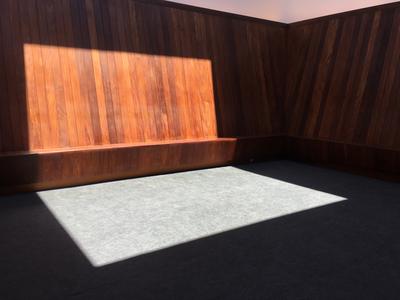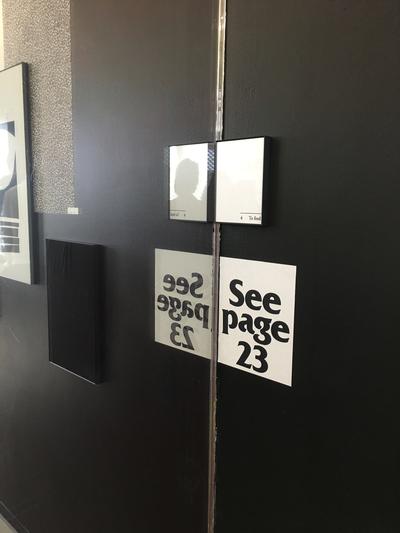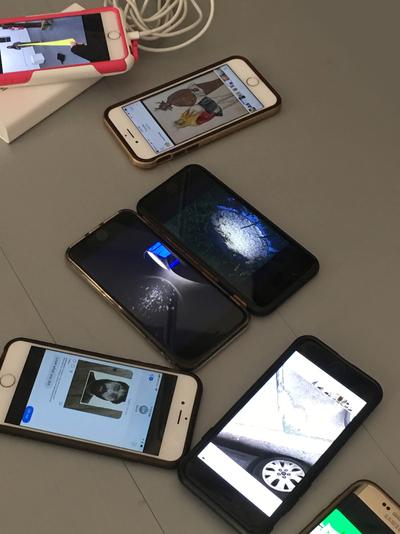Encounters with the Codex: Redefining Forms of Publication
June Yoon
→ MFA GD 2019
Last summer, the New York–based magazine Triple Canopy held its annual Publication Intensive between two sites: New York and Providence. Twelve participants—a diverse group of artists, writers, graphic designers, coders, performers, and educators—took part in seminars, discussions, site visits, and workshops to mine the history of print and analyze “today’s networked forms of production and circulation.” June Yoon (MFA GD 19) and Maia Chao (MFA GL 17) gathered the writings of fellow participants into a booklet of “reflections on a collective experience.” v.1 chose this piece—developed following the author’s participation in Triple Canopy’s Publication Intensive 2018—to share. Thanks to the author and Triple Canopy for their permission to reprint.
 Photographs by the author.
Photographs by the author.
I took this picture at MoMA PS1 in James Turrell’s Skyspace (Meeting)—a serene room with a rectangular window cut through the ceiling—when I noticed that the sunlight cast on the wall and floor looked like an open book. It was the weekend right after the first week of the Triple Canopy Publication Intensive, and images of books were echoing in my mind. During the week, we had traced the history of publications to as early as the design and craft of medieval manuscripts and made connections to contemporary practices of publishing in both print and digital culture. I was especially fascinated by the long-lasting resonance of the codexical form—folded pages bound together, creating a sequence of left- and right-hand spreads in what we know as a book. Struck by my reaction to this persistent shape, I began to wonder why we usually draw the codexical form in our minds when we think of books or publications.
Could the codex be just one manifestation of a publication?
Perhaps a publication is not an image or object itself, but an abstraction based on the translation of the printed page’s ink, substrate, and mechanism to different material or conceptual forms? Is there potential to remix and reinterpret the codex to provide speculative experiences for the reader?
Which brings me back to James Turrell. As I said, the sunlight cast in the room looked like a book, but what if we actually thought of it as one? Like a codex that guides the eye from the left to right page (or right to left), a contained space and its intersecting walls create a sequence of one dimensional plane to another. The substrates are the floor, walls, and ceiling, while the inks are light, shadows, material textures, even bodies moving around in the space. Just as we read the words on a page, we can also read the space of a room.
I took this picture during a conversation and studio visit with Kameelah Janan Rasheen at the New Museum, where the artist had set up a personal archival library of texts on black history and education. Xeroxed pages from the books in her collection appeared on the walls of her hybrid studio and educational space. This particular moment, in which two of her framed pieces reflected on a perpendicular glass wall, yet again reminded me of an open book. This “book” is interesting because the reflection of a single object creates two facing objects. The content is repeated and the reaction—the fuzzy reversed text, the glare of light and dark silhouette—creates the difference between the left and right. From this physical representation of a codex emerges an abstract thought that a publication can be defined as reflection and repetition as well. All it takes is a singular object, body, image, or word reflected and repeated in a material context to create an unexpected reading experience of form.


I took this picture at a workshop with designer Paul Soulellis at the RISD Design Center Commons. Paul asked us to each choose one picture from the camera roll on our phones and place them on a table. Two of the pictures, taken at different times by different people, were particularly similar, so we placed their phones side-by-side like this. It was a small and coincidental moment at the time, but thinking back and looking at this documentation now, I realize that we had created yet another book—a digital codex. Just as the gesture of flipping through the pages of a book reveals conversations between the left and right pages, scrolling through adjacent devices offers a possibly endless sequence of surprising formal relationships and meaning via chance operations.
Publications reveal themselves through simple but rich offerings of interesting juxtapositions in a variety of configurations or media.
All of these observations stemmed from a simple recognition of the book shape in various places. What started as coincidental encounters developed into a practice of finding more opportunities to question and translate the familiar codexical form. Now, I see the “book” everywhere and continue to redefine publication as a concept of space, reflection, repetition, and juxtapositions. As a designer, I am interested in how these abstract considerations invite us to see, read, and communicate in new ways, diversifying the potential forms of publications.
 Photographs by the author.
Photographs by the author.I took this picture at MoMA PS1 in James Turrell’s Skyspace (Meeting)—a serene room with a rectangular window cut through the ceiling—when I noticed that the sunlight cast on the wall and floor looked like an open book. It was the weekend right after the first week of the Triple Canopy Publication Intensive, and images of books were echoing in my mind. During the week, we had traced the history of publications to as early as the design and craft of medieval manuscripts and made connections to contemporary practices of publishing in both print and digital culture. I was especially fascinated by the long-lasting resonance of the codexical form—folded pages bound together, creating a sequence of left- and right-hand spreads in what we know as a book. Struck by my reaction to this persistent shape, I began to wonder why we usually draw the codexical form in our minds when we think of books or publications.
Could the codex be just one manifestation of a publication?
Perhaps a publication is not an image or object itself, but an abstraction based on the translation of the printed page’s ink, substrate, and mechanism to different material or conceptual forms? Is there potential to remix and reinterpret the codex to provide speculative experiences for the reader?
Which brings me back to James Turrell. As I said, the sunlight cast in the room looked like a book, but what if we actually thought of it as one? Like a codex that guides the eye from the left to right page (or right to left), a contained space and its intersecting walls create a sequence of one dimensional plane to another. The substrates are the floor, walls, and ceiling, while the inks are light, shadows, material textures, even bodies moving around in the space. Just as we read the words on a page, we can also read the space of a room.
I took this picture during a conversation and studio visit with Kameelah Janan Rasheen at the New Museum, where the artist had set up a personal archival library of texts on black history and education. Xeroxed pages from the books in her collection appeared on the walls of her hybrid studio and educational space. This particular moment, in which two of her framed pieces reflected on a perpendicular glass wall, yet again reminded me of an open book. This “book” is interesting because the reflection of a single object creates two facing objects. The content is repeated and the reaction—the fuzzy reversed text, the glare of light and dark silhouette—creates the difference between the left and right. From this physical representation of a codex emerges an abstract thought that a publication can be defined as reflection and repetition as well. All it takes is a singular object, body, image, or word reflected and repeated in a material context to create an unexpected reading experience of form.


I took this picture at a workshop with designer Paul Soulellis at the RISD Design Center Commons. Paul asked us to each choose one picture from the camera roll on our phones and place them on a table. Two of the pictures, taken at different times by different people, were particularly similar, so we placed their phones side-by-side like this. It was a small and coincidental moment at the time, but thinking back and looking at this documentation now, I realize that we had created yet another book—a digital codex. Just as the gesture of flipping through the pages of a book reveals conversations between the left and right pages, scrolling through adjacent devices offers a possibly endless sequence of surprising formal relationships and meaning via chance operations.
Publications reveal themselves through simple but rich offerings of interesting juxtapositions in a variety of configurations or media.
All of these observations stemmed from a simple recognition of the book shape in various places. What started as coincidental encounters developed into a practice of finding more opportunities to question and translate the familiar codexical form. Now, I see the “book” everywhere and continue to redefine publication as a concept of space, reflection, repetition, and juxtapositions. As a designer, I am interested in how these abstract considerations invite us to see, read, and communicate in new ways, diversifying the potential forms of publications.
June Yoon is a reader, writer, and thinker who illustrates ideas through the relationship of image and text. Her work focuses on systemic forms and visualizing processes of cognitive patterns.